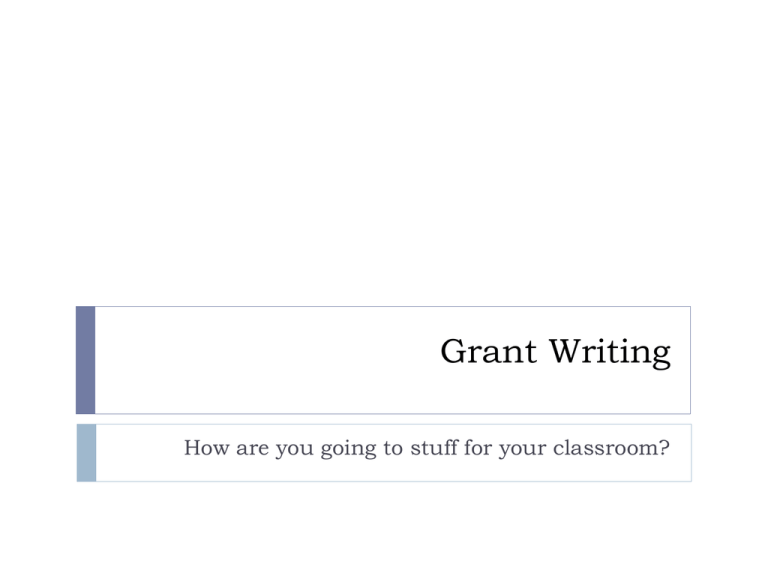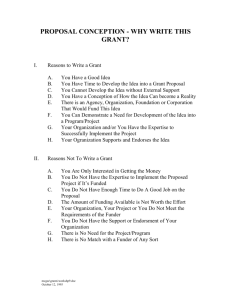Grant Writing How are you going to stuff for your classroom?
advertisement

Grant Writing How are you going to stuff for your classroom? How to get started... Most successful grant writers give the same advice: begin your search for a grant with a Project a Plan a great idea – it is more often than not the idea that is often funded so think about innovative ideas How you are going to implement your great idea Permission. If you’re planning to apply for a major grant you often need administrative sign-off (principal, someone) So you have the three P’s in place Get started early... Document the need mission statement or outcome statement When and what will things be done planned assessment tool(s). Make sure they are specific and measurable. Timeline Identify the project’s potential outcome. goals and objectives with demographics, test results, and anecdotal evidence Again, be specific required materials, supplies, and personnel. total cost Make sure you within the budget of the funder!!!! You have an idea and plan... So... Find funding.... School Grants Center : http://www.educationworld.com/a_admin/archives/grants.shtml Discretionary Grant Application Packages: http://www.ed.gov/fund/grant/apply/grantapps/index.html This site for non-governmental funding resources offers both print and online resources for a subscription fee. eSchool News Online: http://www.eschoolnews.com/resources/enewsletters/alert The National Education Association Foundation for the Improvement of Education offers information, guidelines, and other resources related to grants the foundation administers. The Foundation Center: http://fdncenter.org/ The U.S. Government offers this clickable list of application packages for currently open Department of Education grant competitions. Grants and Programs: http://www.nfie.org/grants.htm Education World offers the latest information about current education grants. Sign up for eSchool News Technology Alert, a free e-mail newsletter containing information about grants and grant deadlines. Community Foundation Locator: http://www.communityfoundationlocator.org/search/index.cfm This tool identifies tax-exempt charitable organizations in your community that are possible sources of grant What typically goes into a grant... Grant application generally consists of three parts: the application form or forms the narrative the budget. Most funders caution applicants to give equal weight to all three sections Narrative Narrative section of the application usually includes: Need: includes the project’s purpose, goals, and measurable objectives. This section can also include background on how and why the project was conceived and should include a compelling reason why the proposal should be funded. Plan: includes an explanation of how the project’s goals and objectives will be met, what activities will be used, what personnel will be needed, and how that personnel will be utilized. Assessment/Evaluation: a discussion of the assessment procedure, including how the project will be evaluated and specific measurement strategies. Timeline: a timeline that includes the start and end dates of the project and a schedule of activities. Who you are: the applicant’s credentials, including information that demonstrates his or her background and ability to carry out the project successfully. Why the project is important (clincher): You won’t find this on the funder’s guidelines, but it’s the critical aspect of your narrative. Provide information in a way that clearly demonstrates to the reviewers why the project is needed and why it is an important funding opportunity for their business or organization. Let the funder know that the project is important to you and that you’re excited about its possibilities Things to keep in mind Your narrative clear, concise, and interesting to read. Write professionally, but avoid too much educational jargon. Often times an easy to read and engaging narrative will be funded over what may be a stronger proposal but harder to read Define any educational buzz words that you do use. (Remember, the reviewers might not be educators! and in most cases are not) Be specific about your project’s goals and objectives -and focus on results! Most importantly, follow the rules set down by the funder The budget The budget provides funders with cost projections for the project. Your budget should be specific, reasonable, realistic, accurate, and flexible -- in case the funder wants to negotiate the funding amount. Be sure to include other revenue sources, if any are available. This could be from your school or district Some districts have an educational foundation and if they would be willing to provide some kind of match so much the better Old saying – money gets more money... Above all, make sure the budget is consistent with the narrative. Don’t include budget items that aren’t mentioned in the proposal or omit costs for projected activities. Extra stuff... Some funding sources may also require a variety of supporting documents as part of the application. Those could include endorsements, resumes, additional project information, visual aids, and so on. Pictures of students engaged in activities are powerful visuals However, Don’t assume that your funder wants -- or even allows -those documents, however. Ask if you aren’t sure. What if I don’t get funded... Getting told no does not mean your idea was bad Getting no happens more than yes - competitive They didn’t fit the socio-economic group the business or organization funds. They didn’t meet the objectives the business or organization had in mind to fund. They focused too much on the equipment. The project’s plan wasn’t thought out well enough. Competition was high.You had an excellent grant prospect, but there were so many good ones, yours didn’t make the cut. The reviewers just didn't like it! What to do after you hear from the funder Write a thank you note to the grant funder and to your contact person. Adhere to the specifications and timeline presented in the grant application. As best you can – can say what happened in your report Provide the promised evaluation documents promptly. Have your students sign it Turn in any reports on time! Write a final report that’s as complete, interesting, and enthusiastic as the grant application. Document your success and include photographs, videos, pod-casts Again, visuals are very powerful for the funder Maintain contact with the funder If they like what you do you may be invited to apply for future grants Summary... Geographic requirements Think creatively... Some funders focus on urban others rural Make sure you are teaching the population the funder wants to support Interests Ideas and Innovations are why most grants get funded Populations Some funders only service a particular geographic area Make sure the funder has an interest in your area Priorities Most funding agencies list their priority areas for funding Funding Range Environment, community outreach, etc... Always make sure you within the budget of the funder Proofread Always, always, always proofread Have someone else read it – see if it makes sense to them Some additional sources for help Basic Elements of Grant Writing SchoolGrants http://www.libraryspot.com/features/grantsfeature.htm LibrarySpot offers resources on locating grants and writing grant proposals. Persuasive Proposal Writing http://www.schoolgrants.org/ This site provides grant-writing tips and sample proposals. Getting Grants http://www.cpb.org/grants/grantwriting.html The Corporation for Public Broadcasting provides this guide to the elements of grant writing. http://www.biu.ac.il/RA/www/rserch/writing/write1.html This document walks prospective grant writers through the entire process, from planning to writing. Grant Writing Sources and Tips http://7-12educators.about.com/library/weekly/aa061500a.htm About.com offers advice on writing grants. Some example places Hewlett-Packard Technology for Teaching http://www.hp.com/hpinfo/grants/us/programs/tech_teaching/k 12_main.html Tool Factory/Olympus Grants www.toolfactory.com/olympus Places to Look examples The Foundation Center www.foundationcenter.org GrantsAlert.com www.grantsalert.com The Grantsmanship Center www.tgci.com Technology Grant News www.technologygrantnews.com School Grants www.schoolgrants.org Donors Choose www.donorschoose.org KaBOOM! / Home Depot www.kaboom.org U Play University Scholarships are available now! Find the Criteria What’s the judging criteria? Every grant will tell you Make sure to match: Sneak Peek - Judging Site Rule #1 No typpos!#*! Rule #2 Properly Grammer useage Rule #3 Must reflect adequate planning Round 1: Yes or No Find the Judging Criteria Make your grant match their criteria! Sneak Peek - Round 2 Think Outside the Box You want: digital cameras and a microscope. Grant’s objectives: Save the environment. How do you make your “Wants”…meet their “Objectives”? Sunderland Elementary School Create Timelines Map out deadlines Pretend everything is due 1 week early Proofread twice - leave time Murphy’s Law stalks grant writers! Writing FOLLOW DIRECTIONS! Regurgitate Tell a story Inject excitement - Find the “Wow”! Proofread Proofread again Start with their mission and objectives, then edit. Remember, it’s their money! Build a Relationship Write letters Call Write more letters Call again Did I forget to say “Write letters”? What do kids do when they want something? Create an Electronic Library School demographics Description of local issues Project descriptions Bios Press releases Press coverage Store it on the server, force everyone to use it. After the Win Thank everyone Press releases Radio, television, newspapers Send progress reports Deliver Winning a grant is your best leverage to winning another grant. Digital Wish Reach out to your community! Create a profile and enter to win 43 grant opportunities at once! www.digitalwish.com


